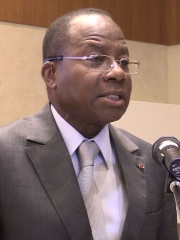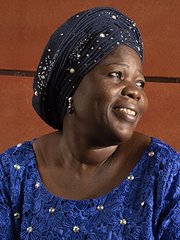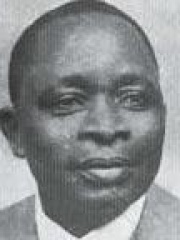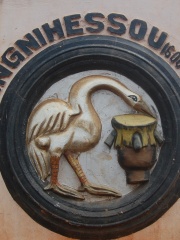
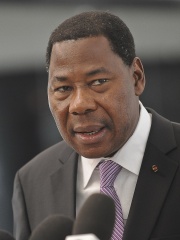
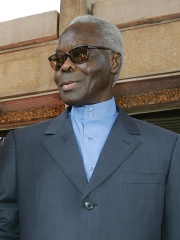
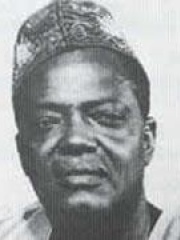
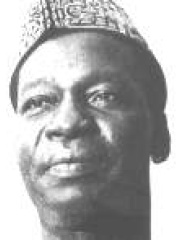
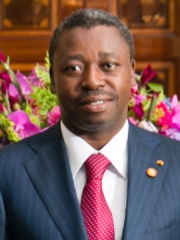
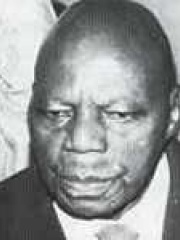
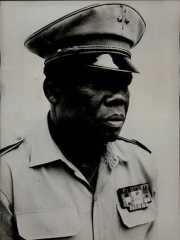
The Most Famous
POLITICIANS from Benin
This page contains a list of the greatest Beninese Politicians. The pantheon dataset contains 19,576 Politicians, 18 of which were born in Benin. This makes Benin the birth place of the 113th most number of Politicians behind Laos, and Kuwait.
Top 10
The following people are considered by Pantheon to be the top 10 most legendary Beninese Politicians of all time. This list of famous Beninese Politicians is sorted by HPI (Historical Popularity Index), a metric that aggregates information on a biography's online popularity. Visit the rankings page to view the entire list of Beninese Politicians.

1. Do-Aklin (1550 - 1700)
With an HPI of 73.60, Do-Aklin is the most famous Beninese Politician. His biography has been translated into 53 different languages on wikipedia.
Do-Aklin or Gangnihessou (Ganye Hessou) or Dogbari is claimed as the founder of the Fon Kingdom of Dahomey in present-day Benin and the first person in the royal lineage of the Kings of Dahomey (the Aladaxonou dynasty). In many versions he is considered the first king of Dahomey even though the kingdom was founded after his death. Very little is known about Do-Aklin and most of it is connected to folklore, but it is generally claimed that he settled a large group of Aja people from Allada on the Abomey plateau amongst the local inhabitants in c. 1620. His son Dakodonu would eventually build a palace on the plateau and began forming the Kingdom of Dahomey.

2. Thomas Boni Yayi (b. 1951)
With an HPI of 69.65, Thomas Boni Yayi is the 2nd most famous Beninese Politician. His biography has been translated into 60 different languages.
Thomas Boni Yayi (born 1 July 1951) is a Beninese banker and politician who was the president of Benin from 2006 to 2016. He took office after winning the March 2006 presidential election and was re-elected to a second term in March 2011. He also served as the chairperson of the African Union from 29 January 2012 to 27 January 2013.

3. Mathieu Kérékou (1933 - 2015)
With an HPI of 68.49, Mathieu Kérékou is the 3rd most famous Beninese Politician. His biography has been translated into 56 different languages.
Mathieu Kérékou (French pronunciation: [ma.tjø ke.ʁe.ku]; 2 September 1933 – 14 October 2015) was a Beninese politician who served as president of the People's Republic of Benin from 1972 to 1991 and the Republic of Benin from 1996 to 2006. After seizing power in a military coup, he ruled the country for 18 years under an officially Marxist–Leninist ideology, before he was stripped of his powers by the National Conference of 1990. He was defeated in the 1991 presidential election but was returned to the presidency in the 1996 election and controversially re-elected in 2001.

4. Hubert Maga (1916 - 2000)
With an HPI of 65.05, Hubert Maga is the 4th most famous Beninese Politician. His biography has been translated into 40 different languages.
Hubert Coutoucou Maga (August 10, 1916 – May 8, 2000) was a politician from Dahomey (now known as Benin). Born a peasant in 1916, Maga served as a schoolmaster from 1936 to 1945, during which time he gradually gained considerable influence among the uneducated. He rose to power despite regionalist politics in Dahomey, and was elected to Dahomey's territorial assembly in 1947 and founded the Northern Ethnical Group, later renamed the Dahomey Democratic Rally (Rassemblement Démocratique du Dahomé). In 1951, Maga was elected to the French National Assembly, where he served in various positions, including premier from 1959 to 1960. When Dahomey gained its independence from France on August 1, 1960, Maga was appointed to the presidency, and was officially elected to that post on December 11. During Maga's term of office, Dahomey's economy collapsed; there was little foreign investment and unemployment rose. In response, he launched a four-year plan in January 1962, the basis of which was to increase agricultural production by forcing the nation's youths to work on the land. Maga also faced a national crisis of unity, culminating in a failed assassination plot against him in May 1961 led by the main opposition leader, Justin Ahomadegbé-Tomêtin. Ahomadegbé-Tomêtin was jailed, and by the time of his release in November 1962, a one-party state had been established and the opposition press had been restricted. In 1963, convicted murderer Christophe Bokhiri was released from prison, prompting riots around the country, but the focus of the rioting soon shifted toward Maga's problems as president. The riots became so serious that the Chief of Staff of the Dahomeyan Army, Christophe Soglo, took control of the country in October to prevent a civil war. After forcing Maga to resign, Soglo gave him, Ahomadégbé-Tomêtin, and vice president Sourou Migan Apithy, the titles of Minister of State. Shortly afterwards, Maga was convicted of plotting to assassinate Soglo and of corruption, for which he was incarcerated. Following his release in 1965, he took refuge in Togo before moving to Paris. In 1970, he returned to Dahomey to serve as head of a rotating three-man Presidential Council, which included Ahomadegbé-Tomêtin and Apithy. On October 26, 1972, Mathieu Kérékou was installed by a coup, overthrowing then-chairman Ahomadegbé-Tomêtin. Maga and the other members of the council were imprisoned until 1981. Maga retired from public life after his release, only making an appearance at the National Conference of 1990, which gave amnesty to all Beninese political refugees. He died on May 8, 2000.
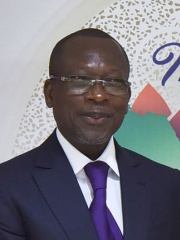
5. Patrice Talon (b. 1958)
With an HPI of 64.34, Patrice Talon is the 5th most famous Beninese Politician. His biography has been translated into 60 different languages.
Patrice Guillaume Athanase Talon (born 1 May 1958) is a Beninese politician and businessman who has served as the eighth president of Benin since 2016.

6. Sourou-Migan Apithy (1913 - 1989)
With an HPI of 61.96, Sourou-Migan Apithy is the 6th most famous Beninese Politician. His biography has been translated into 32 different languages.
Sourou-Migan Marcellin Joseph Apithy (8 April 1913 – 3 December 1989) was a Beninese political figure most active when his country was known as Dahomey. He arose on a political scene where one's power was dictated by what region in Dahomey one lived in. Apithy studied at Bordeaux in a Lycée or secondary school. After he completed his studies there, he was accepted at the public Political Science School in Paris where he took courses in commercial studies. He later worked at a French company in Western Africa as an expert accountant. Before his country acquired its independence, beginning 1945, he was part of Dahomey's Constitutive Assembly and was re-elected for a number of terms. When Hubert Maga nominated him to that function, he was also the prime minister of Dahomey (Benin) from 1957 to 1958. By 1960, he had become Vice President of Dahomey. He served as the 2nd President of Dahomey between 25 January 1964 and 27 November 1965, when he was overthrown by Christophe Soglo after infighting among the members of the government. After this event he fled to Paris for the first time but he returned to Cotonou after the 1970 coup, when he became a member of the Presidential Triumvirate during the early 1970s. Following the 1972 coup, he was put under arrest alongside Justin Ahomadegbé-Tomêtin and Maga, and was not released until 1981. He was sometimes referred to as being part of the 'three-headed monster' of the 1960s in Benin. He died in exile in his Paris house, in December 1989, shortly before the transition to democracy in his country.

7. Faure Gnassingbé (b. 1966)
With an HPI of 61.79, Faure Gnassingbé is the 7th most famous Beninese Politician. His biography has been translated into 64 different languages.
Faure Essozimna Gnassingbé (French pronunciation: [fɔʁ esozimna ɲasiŋɡbe]; born 6 June 1966) is a Togolese politician who has led Togo since 2005, first as the fourth president until 2025 and then as the inaugural president of the council of ministers. A member of the ruling Union for the Republic (UNIR), he is the son of the third president, Gnassingbé Eyadéma. Born in Afagnan, Gnassingbé studied in the United States and France before joining the Rally of the Togolese People (RPT) in 1990. He was appointed by his father as Minister of Equipment, Mines, Posts, and Telecommunications, serving in these roles from 2003 to 2005. Following Eyadéma's death in 2005, Gnassingbé was immediately installed as president with support from the army and was elected president of the National Assembly to further legitimise his succession. However, doubts regarding the constitutional legitimacy of the succession led to heavy regional pressure being placed on Gnassingbé, and he subsequently resigned on 25 February. He then won a controversial presidential election on 24 April, and was sworn in as president. Gnassingbé further ran for three more terms in 2010, 2015 and 2020, after a 2019 constitutional amendment which allowed him to run for two more terms. In 2024, Gnassingbé once again amended Togo's constitution. He stripped off most of the powers of the presidency and transferred the powers to the prime minister, with the role being renamed "president of the Council of Ministers", nominally turning Togo from a presidential republic into a parliamentary one. The change also changed the way on how the president is elected, from being directly elected by the Togolese people to being indirectly elected by the Parliament. Opposition members criticised these changes due to the lack of term limits for Gnassingbé's new position. The changes came into effect in May 2025, when Gnassingbé was sworn in as president of the Council of Ministers, with former opposition leader Jean-Lucien Savi de Tové becoming president. Since June 2025, protests against Gnassingbé grew demanding his resignation. Gnassingbé has been widely criticized for contributing to democratic backsliding in Togo and critics have described him as a dictator.

8. Justin Ahomadégbé-Tomêtin (1917 - 2002)
With an HPI of 61.06, Justin Ahomadégbé-Tomêtin is the 8th most famous Beninese Politician. His biography has been translated into 31 different languages.
Justin Ahomadegbé-Tomêtin (January 16, 1917 – March 8, 2002) was a Beninese politician most active when his country was known as Dahomey. He arose on a political scene where one's power was dictated by what region of Dahomey one lived in. He served as president of the National Assembly of Dahomey from April 1959 to November 1960 and as prime minister and vice president of Dahomey from 1964 to 1965. Ahomadégbé became president of the Presidential Council, which was a system that rotated the office between three leading political figures: Ahomadégbé, Hubert Maga, and Sourou-Migan Apithy. Maga peacefully handed power to Ahomadégbé on May 7, 1972. On October 26, 1972, he was overthrown in a coup d'état led by Mathieu Kérékou. All three remained under house arrest until 1981.

9. Christophe Soglo (1909 - 1983)
With an HPI of 60.53, Christophe Soglo is the 9th most famous Beninese Politician. His biography has been translated into 29 different languages.
Christophe Soglo (28 June 1909 – 7 October 1983) was a Beninese military officer and political leader.
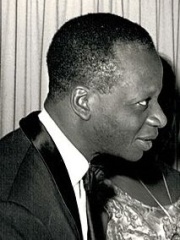
10. Émile Derlin Zinsou (1918 - 2016)
With an HPI of 60.47, Émile Derlin Zinsou is the 10th most famous Beninese Politician. His biography has been translated into 27 different languages.
Émile Derlin Zinsou (23 March 1918 – 28 July 2016) was a Beninese politician and physician who was the President of Dahomey (now Benin) from 17 July 1968 until 10 December 1969, supported by the military regime that took power in 1967. Zinsou was present at the signing of the treaty that formed the African Union on 12 July 2000 in Togo. He was a nationalist.
People
Pantheon has 18 people classified as Beninese politicians born between 1550 and 1967. Of these 18, 7 (38.89%) of them are still alive today. The most famous living Beninese politicians include Thomas Boni Yayi, Patrice Talon, and Faure Gnassingbé. The most famous deceased Beninese politicians include Do-Aklin, Mathieu Kérékou, and Hubert Maga. As of April 2024, 1 new Beninese politicians have been added to Pantheon including Mariam Chabi Talata.
Living Beninese Politicians
Go to all RankingsThomas Boni Yayi
1951 - Present
HPI: 69.65
Patrice Talon
1958 - Present
HPI: 64.34
Faure Gnassingbé
1966 - Present
HPI: 61.79
Adrien Houngbédji
1942 - Present
HPI: 53.26
Coffi Codjia
1967 - Present
HPI: 49.70
Mariam Chabi Talata
1963 - Present
HPI: 49.08
Pascal Koupaki
1951 - Present
HPI: 49.00
Deceased Beninese Politicians
Go to all RankingsDo-Aklin
1550 - 1700
HPI: 73.60
Mathieu Kérékou
1933 - 2015
HPI: 68.49
Hubert Maga
1916 - 2000
HPI: 65.05
Sourou-Migan Apithy
1913 - 1989
HPI: 61.96
Justin Ahomadégbé-Tomêtin
1917 - 2002
HPI: 61.06
Christophe Soglo
1909 - 1983
HPI: 60.53
Émile Derlin Zinsou
1918 - 2016
HPI: 60.47
Alphonse Alley
1930 - 1987
HPI: 56.36
Paul-Émile de Souza
1930 - 1999
HPI: 54.25
Tahirou Congacou
1913 - 1993
HPI: 53.37
Maurice Kouandété
1932 - 2003
HPI: 52.66
Newly Added Beninese Politicians (2025)
Go to all RankingsOverlapping Lives
Which Politicians were alive at the same time? This visualization shows the lifespans of the 10 most globally memorable Politicians since 1700.

